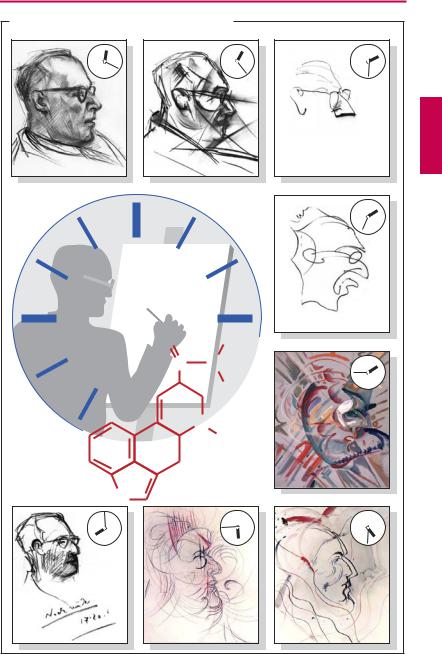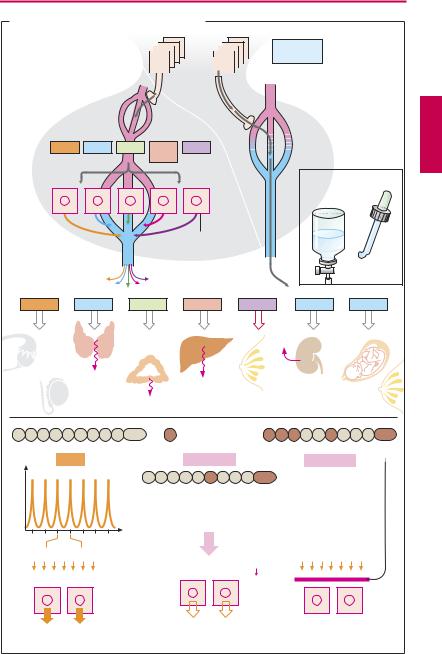
- •Preface to the 3rd edition
- •General Pharmacology
- •Systems Pharmacology
- •Therapy of Selected Diseases
- •Subject Index
- •Abbreviations
- •General Pharmacology
- •History of Pharmacology
- •Drug and Active Principle
- •The Aims of Isolating Active Principles
- •European Plants as Sources of Effective Medicines
- •Drug Development
- •Congeneric Drugs and Name Diversity
- •Oral Dosage Forms
- •Drug Administration by Inhalation
- •Dermatological Agents
- •From Application to Distribution in the Body
- •Potential Targets of Drug Action
- •External Barriers of the Body
- •Blood–Tissue Barriers
- •Membrane Permeation
- •Binding to Plasma Proteins
- •The Liver as an Excretory Organ
- •Biotransformation of Drugs
- •Drug Metabolism by Cytochrome P450
- •The Kidney as an Excretory Organ
- •Presystemic Elimination
- •Drug Concentration in the Body as a Function of Time—First Order (Exponential) Rate Processes
- •Time Course of Drug Concentration in Plasma
- •Time Course of Drug Plasma Levels during Repeated Dosing (A)
- •Time Course of Drug Plasma Levels during Irregular Intake (B)
- •Accumulation: Dose, Dose Interval, and Plasma Level Fluctuation (A)
- •Dose–Response Relationship
- •Concentration–Effect Curves (B)
- •Concentration–Binding Curves
- •Types of Binding Forces
- •Agonists—Antagonists
- •Other Forms of Antagonism
- •Enantioselectivity of Drug Action
- •Receptor Types
- •Undesirable Drug Effects, Side Effects
- •Drug Allergy
- •Cutaneous Reactions
- •Drug Toxicity in Pregnancy and Lactation
- •Pharmacogenetics
- •Placebo (A)
- •Systems Pharmacology
- •Sympathetic Nervous System
- •Structure of the Sympathetic Nervous System
- •Adrenergic Synapse
- •Adrenoceptor Subtypes and Catecholamine Actions
- •Smooth Muscle Effects
- •Cardiostimulation
- •Metabolic Effects
- •Structure–Activity Relationships of Sympathomimetics
- •Indirect Sympathomimetics
- •Types of
- •Antiadrenergics
- •Parasympathetic Nervous System
- •Cholinergic Synapse
- •Parasympathomimetics
- •Parasympatholytics
- •Actions of Nicotine
- •Localization of Nicotinic ACh Receptors
- •Effects of Nicotine on Body Function
- •Aids for Smoking Cessation
- •Consequences of Tobacco Smoking
- •Dopamine
- •Histamine Effects and Their Pharmacological Properties
- •Serotonin
- •Vasodilators—Overview
- •Organic Nitrates
- •Calcium Antagonists
- •ACE Inhibitors
- •Drugs Used to Influence Smooth Muscle Organs
- •Cardiac Drugs
- •Cardiac Glycosides
- •Antiarrhythmic Drugs
- •Iron Compounds
- •Prophylaxis and Therapy of Thromboses
- •Possibilities for Interference (B)
- •Heparin (A)
- •Hirudin and Derivatives (B)
- •Fibrinolytics
- •Intra-arterial Thrombus Formation (A)
- •Formation, Activation, and Aggregation of Platelets (B)
- •Inhibitors of Platelet Aggregation (A)
- •Presystemic Effect of ASA
- •Plasma Volume Expanders
- •Lipid-lowering Agents
- •Diuretics—An Overview
- •NaCl Reabsorption in the Kidney (A)
- •Aquaporins (AQP)
- •Osmotic Diuretics (B)
- •Diuretics of the Sulfonamide Type
- •Potassium-sparing Diuretics (A)
- •Vasopressin and Derivatives (B)
- •Drugs for Gastric and Duodenal Ulcers
- •Laxatives
- •Antidiarrheal Agents
- •Drugs Affecting Motor Function
- •Muscle Relaxants
- •Nondepolarizing Muscle Relaxants
- •Depolarizing Muscle Relaxants
- •Antiparkinsonian Drugs
- •Antiepileptics
- •Pain Mechanisms and Pathways
- •Eicosanoids
- •Antipyretic Analgesics
- •Nonsteroidal Anti-inflammatory Drugs (NSAIDs)
- •Cyclooxygenase (COX) Inhibitors
- •Local Anesthetics
- •Opioid Analgesics—Morphine Type
- •General Anesthesia and General Anesthetic Drugs
- •Inhalational Anesthetics
- •Injectable Anesthetics
- •Sedatives, Hypnotics
- •Benzodiazepines
- •Pharmacokinetics of Benzodiazepines
- •Therapy of Depressive Illness
- •Mania
- •Therapy of Schizophrenia
- •Psychotomimetics (Psychedelics, Hallucinogens)
- •Hypothalamic and Hypophyseal Hormones
- •Thyroid Hormone Therapy
- •Glucocorticoid Therapy
- •Follicular Growth and Ovulation, Estrogen and Progestin Production
- •Oral Contraceptives
- •Antiestrogen and Antiprogestin Active Principles
- •Aromatase Inhibitors
- •Insulin Formulations
- •Treatment of Insulin-dependent Diabetes Mellitus
- •Treatment of Maturity-Onset (Type II) Diabetes Mellitus
- •Oral Antidiabetics
- •Drugs for Maintaining Calcium Homeostasis
- •Drugs for Treating Bacterial Infections
- •Inhibitors of Cell Wall Synthesis
- •Inhibitors of Tetrahydrofolate Synthesis
- •Inhibitors of DNA Function
- •Inhibitors of Protein Synthesis
- •Drugs for Treating Mycobacterial Infections
- •Drugs Used in the Treatment of Fungal Infections
- •Chemotherapy of Viral Infections
- •Drugs for the Treatment of AIDS
- •Drugs for Treating Endoparasitic and Ectoparasitic Infestations
- •Antimalarials
- •Other Tropical Diseases
- •Chemotherapy of Malignant Tumors
- •Targeting of Antineoplastic Drug Action (A)
- •Mechanisms of Resistance to Cytostatics (B)
- •Inhibition of Immune Responses
- •Antidotes and Treatment of Poisonings
- •Therapy of Selected Diseases
- •Hypertension
- •Angina Pectoris
- •Antianginal Drugs
- •Acute Coronary Syndrome— Myocardial Infarction
- •Congestive Heart Failure
- •Hypotension
- •Gout
- •Obesity—Sequelae and Therapeutic Approaches
- •Osteoporosis
- •Rheumatoid Arthritis
- •Migraine
- •Common Cold
- •Bronchial Asthma
- •Emesis
- •Alcohol Abuse
- •Local Treatment of Glaucoma
- •Further Reading
- •Further Reading
- •Picture Credits
- •Drug Indexes

236 Psychopharmacologicals
Psychotomimetics (Psychedelics, Hallucinogens)
Psychotomimetics are able to elicit psychic changes like those manifested in the course of a psychosis, such as illusionary distortion of perception and hallucinations. This experience may be dreamlike in character; its emotional or intellectual transposition appears incomprehensible to the outsider.
A psychotomimetic effect is pictorially recorded in the series of portraits drawn by an artist under the influence of lysergic acid diethylamide (LSD). As the intoxicated state waxes and wanes wavelike, he reports seeing the face of the portrayed subject turn into a grimace, phosphoresce bluish-purple, and fluctuate in size as if viewed through a moving zoom lens, creating the illusion of abstruse changes in proportion and grotesque motion sequences. The diabolic caricature is perceived as threatening.
Illusions also affect the senses of hearing and smell; sounds (tones) are “experienced” as floating beams and visual impressions as odors(“synesthesia”).Intoxicatedindividuals see themselves temporarily from the outside and pass judgment on themselves and their condition.Theboundarybetweenselfandthe environment becomes blurred. An elating sense of being one with the other and the cosmos sets in. The sense of time is suspended;thereisneitherpresentnorpast.Objects are seen that do notexist, and experiences are feltthat transcend explanation, hence the term “psychedelic” (Greek delosis = revelation) implying expansion of consciousness.
The contents of such illusions and hallucinations can occasionally become extremely threatening (a “bad trip” or “bum trip”); the individual may feel provoked to turn violent or to commit suicide. Intoxication is followed by a phase of intense fatigue, feelings of shame, and humiliating emptiness.
The mechanism of the psychotogenic effect remains unclear. LSD and some natural hallucinogens such as psilocin, psilocybin (from fungi), bufotenin (the cutaneous gland
secretion of a toad), and mescaline (from the Mexican cactus Anhalonium lewinii—peyote) bear structural resemblance to 5HT (p.120) and chemically synthesized amphetaminederived hallucinogens (4-methyl-2,5-dime- thoxyamphetamine, 3,4-dimethoxyamphet- amine, 2,5-dimethoxy-4-ethylamphet- amine) that are thought to interact with the agonist recognition site of the 5-HT2A receptor. Conversely, most of the psychotomimetic effects are annulled by neuroleptics having 5-HT2A antagonist activity (e.g., clozapine, risperidone). The structures of other agents such as tetrahydrocannabinol (from the hemp plant, Cannabis sativa—hashish, marihuana), muscimol (from the fly agaric,
Amanita muscaria), or phencyclidine (formerly used as injectable general anesthetic) donotrevealasimilarconnection.Hallucinations may also occur as adverse effects after intake of other substances, e.g., scopolamine (medieval witches’ ointment) and other cen- trally-active parasympatholytics. Naturally occurring hallucinogens are employed by priests (shamans) of nature religions to achieve a trance state. Synthetic LSD was popular among artists in the 1960s; “psychedelic art” denotes pictorial representation of experiential spaces and hallucinatory signs that elude rational comprehension.
In addition, other drugs that do not act as primary hallucinogens, such as methylenedioxyamphetamine derivatives (e.g., 3,4- dimethylene-dioxymethamphetamine, “Ecstasy”) and cocaine pose a health risk. The acute intoxication is associated with a misperception of reality, a period of exhaustion follows. After prolonged use, dependence develops associated with intellectual degradation and physical decay. Withdrawal therapy is very dif cult. Marihuana frequently serves as an entry-level recreational substance for hard drugs.
Psychotomimeticsare devoid of therapeutic value; however, since their use leads to toxic effects and permanent damage, their manufacture and commercial distribution areprohibited(ScheduleI,ControlledDrugs).
Luellmann, Color Atlas of Pharmacology © 2005 Thieme
All rights reserved. Usage subject to terms and conditions of license.

|
|
Psychotomimetics |
237 |
A. Psychotomimetic effect of LSD in a portrait artist |
|
||
|
O |
C2H5 |
|
|
C |
N |
|
|
|
C2H5 |
|
|
|
N |
|
|
|
CH3 |
|
Lysergic acid |
|
|
|
diethylamide |
|
|
|
0.0001 g/70 kg |
HN |
|
|
|
|
|
|
Luellmann, Color Atlas of Pharmacology © 2005 Thieme
All rights reserved. Usage subject to terms and conditions of license.

238 Hormones
Hypothalamic and Hypophyseal Hormones
The endocrine system is controlled by the brain. Nerve cells of the hypothalamus synthesize and release messenger substances that regulate adenohypophyseal (AH) hormone release or that are themselves secreted into the body as hormones. The latter comprise the so-called neurohypophyseal (NH) hormones.
The axonal processes of hypothalamic neurons project to the neurohypophysis, where they store the nonapeptides vasopressin (= antidiuretic hormone, ADH) and oxytocin and release them on demand into the blood. Therapeutically (ADH, p.168, oxytocin, p.130), these peptide hormones are given parenterally or via the nasal mucosa.
The hypothalamic releasing hormones are peptides. They reach their target cells in the AH lobe by way of a portal vascular route consisting of two seriallyconnected capillary beds. The first of these lies in the hypophyseal stalk, the second corresponds to the capillary bed of the AH lobe. Here, the hypothalamic hormones diffuse from the blood to their target cells, whose activity they control. Hormones released from the AH cells enter the blood, in which they are distributed to peripheral organs (1).
Nomenclature of releasing hormones.
(RH – releasing hormone; RIH – release-in- hibiting hormone.)
GnRH, gonadotropin-RH = gonadorelin: stimulates the release of FSH (follicle-stim- ulating hormone) and LH (luteinizing hormone).
TRH, thyrotropin-RH (protirelin): stimulates the release of TSH (thyroid-stimulating hormone = thyrotropin).
CRH, corticotropin-RH: stimulates the release of ACTH (adrenocorticotropic hormone = corticotropin).
GRH, growth hormone-RH = somatorelin: stimulates the release of GH (growth hormone = STH, somatotropic hormone).
GRIH = somatostatin: inhibits release of STH (and also other peptide hormones including insulin, glucagon and gastrin).
PRIH inhibits the release of prolactin and is identical with dopamine.
Therapeutic control of AH cells. GnRH is used in hypothalamic infertility in women to stimulate FSH and LH secretion and to induce ovulation. For this purpose, it is necessary to mimic the physiological intermittent release (“pulsatile,” approximately every 90 minutes) by means of a programmed infusion pump.
Gonadorelin superagonists are GnRH analogues that bind with very high avidity to GnRH receptors of AH cells. As a result of the nonphysiological uninterrupted receptor stimulation, initial augmentation of FSH and LH output is followed by a prolonged decrease. Buserelin, leuprorelin, goserelin, and triptorelin are used to shut down gonadal function in this manner (“chemical castration,” e.g., in advanced prostatic carcinoma). Gonadorelin receptor antagonists, such as cetrorelix and ganirelix, block the GnRH receptors of AH cells and thus cause cessation of gonadotropin release (2).
The dopamine D2 agonists, bromocriptine and cabergoline (p.116), inhibit prolac- tin-releasing AH cells (indications: suppression of lactation, prolactin-producing tumors). Excessive, but not normal, growth hormone release can also be inhibited (indication: acromegaly).
Octreotide is a somatostatin analogue; it is used in the treatment of somatostatinsecreting pituitary tumors.
Growth hormone requires mediation by somatomedins for many of its actions. These are chiefly formed in the liver, including the important somatomedin C (= insulin-like growth factor 1, IGF-1). Pegvisomant is a newly developed antagonist at the GH receptor and inhibits the production of IGF-1.
Luellmann, Color Atlas of Pharmacology © 2005 Thieme
All rights reserved. Usage subject to terms and conditions of license.

Hypothalamic and Hypophyseal Hormones |
239 |
A. Hypothalamic and hypophyseal hormones
Hypothalamic releasing hormones
Synthesis
Release into blood
 us
us
 Hypothalam
Hypothalam 


ADH
Oxytocin
Synthesis
Release into blood
Control of synthesis and release of
AHhormones
GnRH |
TRH |
CRH |
GRH |
PRIH |
|
|
|
GRIH |
|
Neurohypophysis |
|
Adenohypophysis |
|
AH-cells |
(AH) |
|
|
Application
parenteral
nasal
FSH, LH |
TSH |
Ovum maturation; Estradiol, Progesterone
Thyroxine
Spermatogenesis;
Testosterone
1
GnRH
Released amount |
Pulsatile release |
|
90 min
Rhythmic stimulation
AHcell
ACTH |
STH(GH) |
Prolactin |
ADH |
Oxytocin |
|
Somatomedins |
|
H2O |
|
|
Growth |
|
|
Labor |
|
|
|
|
|
Cortisol |
|
Lactation |
|
Milk ejection |
|
Altered AA |
|
|
|
|
Buserelin |
|
Cetrorelix |
|
GnRH receptor antagonist
Superagonist
Persistent stimulation
GnRH receptor sensitivity
FSH |
LH |
Cessation of hormone secretion |
2
Luellmann, Color Atlas of Pharmacology © 2005 Thieme
All rights reserved. Usage subject to terms and conditions of license.
